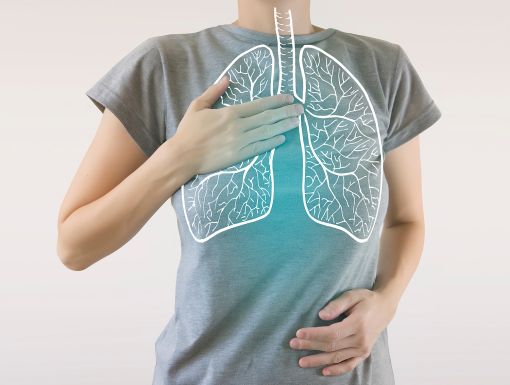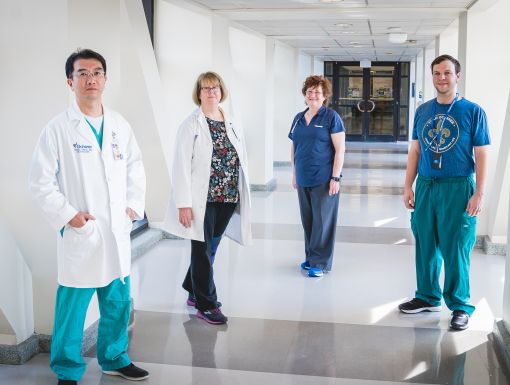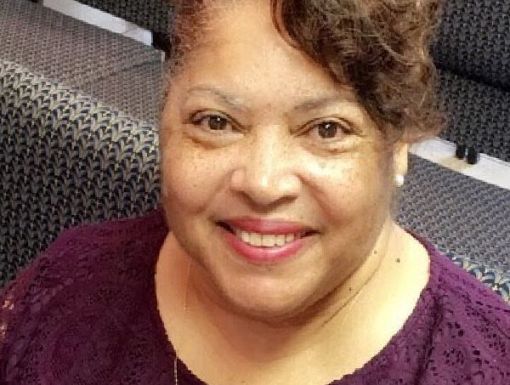
COVID-19 Caretaker Spotlight: Radiology
For every patient suspected or confirmed with COVID-19, there is a team of medical professionals working to diagnose and treat the disease, some seen and some unseen. The ones we see the most are nurses, physicians and respiratory therapists, all working directly in COVID units and at patient bedsides. Ironically, the ones we typically don’t see are the staff who work in a field that sees it all: imaging.
Imaging services takes multiple forms, called modalities. From the ones you know well, like X-ray, to ones you’re likely not as familiar with, like interventional and nuclear radiology, we give providers a noninvasive look into the body to make an informed diagnosis and treatment plan. Our team consists primarily of radiologic technologists, or rad techs, who earn an associate or bachelor’s degree, some of whom specialize in particular areas of imaging. Radiologists, physicians who use radiological technology to diagnose and treat injuries and diseases, oversee the radiology department.
Together, we determine subtle differences in image details that could mean the difference between very different diseases. Small changes in color, shape or placement can reveal incredibly different diagnoses, which in turn impact a patient’s treatment and care. Without radiology, physicians function relatively in the dark, focused primarily on patient symptoms. With imaging, things like tumors can be found early on and treated to stop or prevent additional harm. The same is true of COVID-19, revealing how advanced the disease is at the time of the scan and what next steps should be taken by medical teams.
Radiologist Ernest Rudman, MD at Ochsner Medical Center – New Orleans says, “COVID looks like pretty severe pneumonia, the type of pneumonia we tend to see in older and immunocompromised patients. With COVID, we see it in patients without a real medical history. That’s a pretty distinct pattern.”
Every patient with suspected or positive COVID-19 receives a chest X-ray. My team of X-ray techs has worked nonstop, performing nearly 100 chest X-rays per day. When we take a scan of a patient who has symptoms of COVID-19, the image will reveal what is called ground-glass opacities, light-colored patches within the lungs. This sort of image is also often found in pneumonia. The lungs should be filled with air, revealing a scan that appears black. When you see opacities in there, we know the patient is having trouble breathing.
“I’ve never seen this stream of patients through the ER with the same looking lungs one after the other. A few weeks to a month it was constant, but now we’re seeing a lot fewer new patients come through,” Rudman says.
The immense influx of sick patients has required our radiology teams to be extremely flexible. For example, we perform most scans in a specific room where the radiology machinery sits. During COVID, we’ve made use of our portable X-ray machines, which enable us to travel to the patient instead of transporting them to another location. This helps prevent additional exposure throughout the hospital but increases exposure to our teams.
“We’re doing a lot to mitigate the risk. We’re using waiting rooms differently. Cleaning rooms in very different way. Patients wait in their cars and wait for their appointment rather than be in close proximity to one another. That’s going to be the new normal,” Rudman says.
When a CT scan is used, reserved for the most acute patients, it requires moving through the hospital, down hallways and into scanning rooms. Whether we transport the patient or not, our team is still traveling throughout the hospital all day, increasing their risk of exposure.
Rudman says, “Particularly in this latest pandemic, radiology has really been at the front of diagnosing these patients and starting their treatment. Rad techs are often the first to interact with these patients. They are at as high risk as anyone who interacts with them. Many have other medical problems. Radiology techs, ultrasound, CT – they all spend time talking to patients and positioning them for sometimes extended periods of time. A significant number of them caught COVID. Even I caught COVID, and have returned to work.”
The adaptability of our team is one of our greatest strengths throughout our COVID-19 response. Megan Weidenbacher is one of the radiology techs on my team who contracted COVID-19. Her case was mild to moderate, presenting less intense symptoms than those we typically see at the hospital. She remained home to recover for several weeks but came back with a new appreciation for the role that our team plays in the life of a COVID-19 patient.
“Now when I go into patient rooms, I try to be their 'on-site family', trying to inspire and encourage them. I know I hated not being able to see my family while in isolation and I didn’t even have as bad of a case as most our patients do. I think the biggest burden is actually on the families. I’m sure some think, ‘Should I go see my mom in the hospital today, or wait until tomorrow when it might be too late?’ It’s important to me to make sure patients and their families feel like we really care – and we do,” Weidenbacher says.
That level of compassion translates into a positive team environment amidst all the changes we have experienced. Changes in personal protective equipment protocols, units becoming specific COVID-19 units and everything surrounding the stress of offloading our elective procedures while dealing with a huge influx of symptomatic patients caused a massive shift to what our standard workflow looks like day-to-day.
Rudman echoes this sentiment: “The team has been fantastic. I work with the leadership in X-ray and they have stepped up their adjustment to available of PPE, scheduling changes and changes in workflow. Radiology is often perceived as being in the background. Patients often don’t have a clear sense on what impact radiology has in their care. It’s often invaluable.”
I am proud of their drive and perseverance through it all and proud to be part of Ochsner’s response to COVID-19.
Rudman agrees. “I think Ochsner has done a really great job of handling this. In the region, they’ve stepped up more than others. They’ve had a fantastic response opening testing labs, drive through testing, changing floors, what everyone does to take care of patients – they were always ahead.”
The information in this blog post is accurate at the time of publication. However, as the situation surrounding COVID-19 continues to change, it's possible that information has changed since being published. While Ochsner Health is trying to keep our blog posts as up-to-date as possible, we also encourage readers to stay informed on news and recommendations by using the CDC website.



